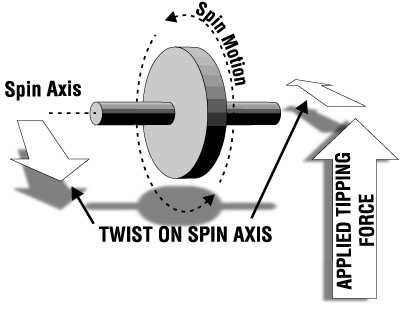 |
|
|
 |
|
|
Not a member? Join Today to see why so many say they are Proud to be a Venturer!
|
|
| Gyroscopic Precession |
|
Author: Archives Views: 5565 Votes: 1 |
Gyroscopic Precession Ever wonder what makes your bike stay vertical and not just tip over as soon as you take your feet off the ground? Well, it's not because you're balancing it. It's due to a phenomenon called gyroscopic precession. This is the tendency of the spin axis of a rotating body to twist at right angles to any applied tipping force. This affects all spinning bodies including the planet Earth, which wobbles on its axis like a top, giving rise to the "precession of the equinoxes". You can feel this force by gripping the axel of a spinning wheel and trying to tilt it. The strange twisting motion that results is due to gyroscopic precession. It’s this effect which makes a moving two wheel bike turn in the direction that the rider leans. Ever wonder what makes your bike stay vertical and not just tip over as soon as you take your feet off the ground? Well, it's not because you're balancing it. It's due to a phenomenon called gyroscopic precession. This is the tendency of the spin axis of a rotating body to twist at right angles to any applied tipping force. This affects all spinning bodies including the planet Earth, which wobbles on its axis like a top, giving rise to the "precession of the equinoxes". You can feel this force by gripping the axel of a spinning wheel and trying to tilt it. The strange twisting motion that results is due to gyroscopic precession. It’s this effect which makes a moving two wheel bike turn in the direction that the rider leans.
You can test this theory by cruising on a straight and level highway at say, 50 MPH, put the cruise control on and then jump off the bike. After some initial instability, you will see your bike drive off into the distance on a straight and stable course until it hits something that causes it to go unstable and crash. I personally do not recommend this experiment. At very low speeds, you steer the bike by turning the handle bars in the direction you want the bike to go. At higher speeds, the bike is turned by leaning it towards the radial center of the turn. To make it start leaning, you must actually cause the bike to fall over in the direction of the desired lean by applying force to the handle bars in a direction opposite to the desired turn direction. Once the bike is leaning and turning at the desired radius, it stays there with little or no steering force input on the handle bars. To make it go straight up again, the handle bars are forced in the same direction as the turn and precession causes a force at right angles to the applied force, thus standing the bike up again.
Last update: 06:34 PM Sunday, September 26, 2004 |
| All material on webpages under the domain venturers.org, is the property of The Venturers, Inc. These materials are protected by copyright and other intellectual property laws. You may not reproduce or retransmit the materials, in whole or in part, in any manner, without the prior written consent of The Venturers, Inc. The free information contained herein is offered in the spirit of helping others and any action or advice taken from these pages is the sole responsibility of the receiver. |